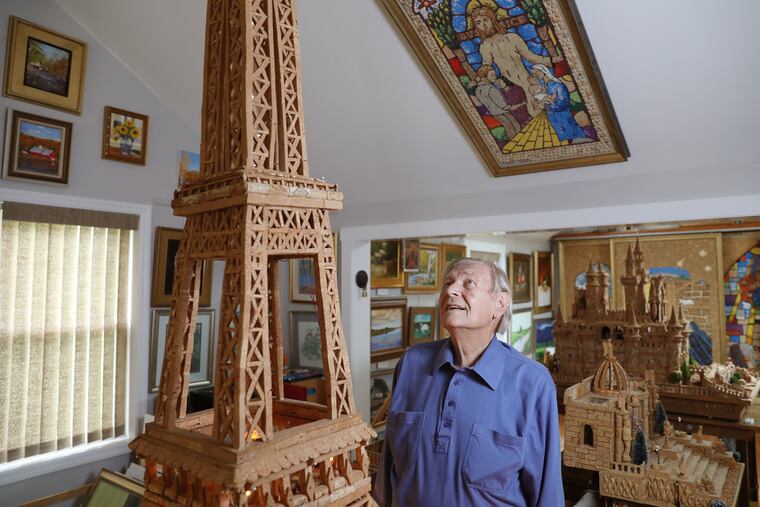92-year-old Montgomery County artist uses 2,000 wine corks to recreate the Eiffel Tower — while battling leukemia
"I look at chemo the same way I look at the Eiffel Tower, a challenge I’d overcome,” Walter Deuschle said.

Walter Deuschle likes a challenge. At 92 years old, he’s out trimming bushes and pulling weeds. He’s planting grass seeds, praying for new growth. And on most mornings, he’s inside his Huntingdon Valley home’s art studio, picking up a paintbrush or a sculpting utensil.
His latest project? A 7½-foot-tall Eiffel Tower made of wine corks. Across nine months, Deuschle has used a Swiss Army knife to chisel nearly 2,000 corks, holding each inch-long cylinder between weathered fingers and turning them into building blocks. It’s a meditation he credits with helping him get through not only the pandemic, but a much larger personal challenge.
In January 2019, two months after completing his previous cork sculpture, a 40-inch-high, 56-inch-wide replica of Cinderella’s Castle in Disney World’s Magic Kingdom, Deuschle was diagnosed with leukemia. He never saw it coming, but he would not let it kill his spirits.
“I’ve had some breakdowns mentally — even though I passed 92, you still want to be young, to stay vigorous and productive,” says Deuschle. “But I look at chemo the same way I look at the Eiffel Tower, a challenge I’d overcome.”
Deuschle goes to the doctor for chemotherapy monthly, each time for four days in a row. Naturally, he’s tired. Most afternoons he spends lying down or taking naps, especially in the days following treatment. But there’s rarely a day where he doesn’t first spend at least 30 minutes, and usually far longer, working on his art.
“It helps me generate energy — it requires concentration, and you need to develop energy to concentrate, and that helps me spiritually,” says Deuschle.
His wife, Mary, has talked with his doctor about the Eiffel Tower. Both view it as a form of medicine.
“It was an extreme, extreme help during this time,” she says. “He’s not one to sit around. This gave him purpose, something to look forward to, and that’s what you need, especially when you have a health issue.”
About 10 years ago, Deuschle and his wife visited the real Eiffel Tower in Paris. The most memorable part for Deuschle was sharing a meal inside its restaurant, which offers views of the Trocadéro Gardens and the Palais de Chaillot. But he says the inspiration for his project had little to do with their trip.
“I have this little replica, maybe 12-inches tall, and I picked it up one day, and just said to myself, ‘This is it’,” Deuschle says. “The Eiffel Tower was a real challenge, and I wanted that challenge.”
He got to work on the tower in January, drawing rough blueprints, carving corks, and then using Elmer’s Glue and a few wire rods to put it all together.
“It took me about three tries to come up with the bottom arch, but the hardest part was actually the long tower at the top, because it’s all one piece and everything needed to be perfectly uniform to stay level,” says Deuschle.
Lit up on the first level of the tower is a re-creation of the restaurant that Deuschle remembers most. He calls it the “Tiffany Room,” complete with four miniature Tiffany lamps, as well as little chairs, a table, and a carpet all made from cork. The room overlooks a courtyard filled with eight miniature street lights, fake green trees, cork-crafted benches, and a burgundy-accented plaza that utilizes corks from red wine bottles.
Deuschle came to Philadelphia in 1956 from Stuttgart, Germany, to work as a chef for the company that became Aramark. He moved up the ladder, then managed a country club before retiring 25 years ago. He picked up the cork-carving hobby in retirement as a way to keep his fidgety hands occupied. In the 15 years since, he’s completed dozens of sculptures.
The Eiffel Tower stands as his tallest, finished three months earlier than expected. It’s one of the few upsides of the pandemic, he says.
“I thought it’d take a full year, but the coronavirus gave me an opportunity to work on it every day,” says Deuschle.
He adds with a laugh, “My wife says I have a lot of patience for this, but I lack a bit of patience for everything else."
Deuschle and his wife have five kids, combined from previous marriages. But because of the pandemic, they seldom get to see them. Like many their age, they’re cautious, living sometimes painstakingly low-key.
“But we’re not afraid,” says Deuschle. “We listen to the doctor, we keep our distance.”
Occasionally, they venture out to a restaurant, as they planned to do Sunday to celebrate their 29th wedding anniversary. Deuschle also enjoys meditating on his porch, and will soon shift his focus from sculpting to painting. But the Eiffel Tower won’t be his last cork project, he says.
Once the pandemic dies down, he hopes to share the tower with as many people as possible. His dream is to have it displayed in a museum or somewhere for the public to enjoy.
“Now that it’s finished, I feel relieved,” says Deuschle. “Sometimes I sit there, and I’m looking at my creation, and then I’m looking around for the guy who put it together.”